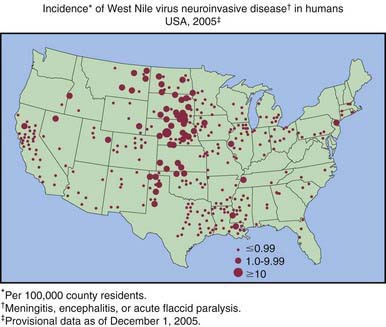Chapter 259 Arboviral Encephalitis in North America
Epidemiology
Eastern Equine Encephalitis
In the USA, EEE is a very low incidence disease, with a median of 8 cases occurring annually in the Atlantic and Gulf States from 1964-2007 (Fig. 259-1). Transmission occurs often in focal endemic areas of the coast of Massachusetts, the 6 southern counties of New Jersey, and northeastern Florida. In North America, the virus is maintained in freshwater swamps in a zoonotic cycle involving Culiseta melanura and birds. Various other mosquito species obtain viremic meals from birds and transmit the virus to horses and humans. Virus activity varies markedly from year to year in response to still unknown ecologic factors. Most infections in birds are silent, but infections in pheasants are often fatal, and epizootics in these species are used as sentinels for periods of increased viral activity. Cases have been recognized on Caribbean islands. The case : infection ratio is lowest in children (1 : 8) and somewhat higher in adults (1 : 29).
Western Equine Encephalitis
WEE infections occur principally in the USA and Canada west of the Mississippi River (see Fig. 259-1), mainly in rural areas where water impoundments, irrigated farmland, and naturally flooded land provide breeding sites for Culex tarsalis. The virus is transmitted in a cycle involving mosquitoes, birds, and other vertebrate hosts. Humans and horses are susceptible to encephalitis. The case : infection ratio varies by age, having been estimated at 1 : 58 in children younger than 4 yr and 1 : 1,150 in adults. Infections are most severe at the extremes of life; a third of cases occur in children younger than 1 yr. Recurrent human epidemics have been reported from the Yakima Valley in Washington State and the Central Valley of California; the largest outbreak on record resulted in 3,400 cases and occurred in Minnesota, North and South Dakota, Nebraska, and Montana as well as Alberta, Manitoba, and Saskatchewan, Canada. Epizootics in horses precede human epidemics by several weeks. For the past 20 yr, only 3 cases of WEE have been reported, presumably reflecting successful mosquito abatement.
St. Louis Encephalitis
Cases of SLE are reported from nearly all states; the highest attack rates occur in the Gulf and central states (see Fig. 259-1). Epidemics frequently occur in urban and suburban areas; the largest, in 1975, involved 1,800 persons living in Houston, Chicago, Memphis, and Denver. Cases often cluster in areas where there is ground water or septic systems, which support mosquito breeding. The principal vectors are Culex pipiens and Culex quinquefasciatus in the central Gulf States, Culex nigripalpus in Florida, and Culex tarsalis in California. SLE virus is maintained in nature in a bird-mosquito cycle. Viral amplification occurs in bird species abundant in residential areas (e.g., sparrows, blue jays, and doves). Virus is transmitted in the late summer and early fall. The case : infection ratio may be as high as 1 : 300. Age-specific attack rates are lowest in children and highest in individuals older than 60 yr. The most recent small outbreaks were in Florida in 1990 and Louisiana in 2001. For the past 15 years there have been a mean of 18 cases annually.
West Nile Encephalitis
WNE virus has been implicated as the cause of sporadic summertime cases of human encephalitis and meningitis in Israel, India, Pakistan, Romania, Russia, and the USA. All American WNE viruses are genetically similar and are related to a virus recovered from a goose in Israel in 1998. WNE virus survives in a broad enzootic cycle in the USA and within 4 yr had spread to most states east of the Rocky Mountains plus California (Fig. 259-2). Every state in the continental USA plus 9 provinces in Canada have reported mosquito, bird, mammalian, or human West Nile infection. Through the end of 2008 28,813 total cases had been reported, 30-40% of which were encephalitis, with 1064 deaths. Summer/fall epidemics are common (Fig. 259-3). West Nile virus has entered the blood supply through asymptomatic viremic blood donors. Blood banks screen for West Nile virus RNA (Fig. 259-4). West Nile virus has also been transmitted to humans via the placenta, breast milk, and organ transplantation. Throughout its range, the virus is maintained in nature by transmission between mosquitoes of the Culex genus and various species of birds. In the USA, human infections are largely acquired from Culex pipiens. Horses are the non-avian vertebrates most likely to exhibit disease with WNE infection. During the 2002 transmission season, 14,000 equine cases were reported, with a mortality rate of 30%. Disease occurs predominantly in individuals >50 yr of age.

Figure 259-2 Incidence of West Nile virus neuroinvasive disease in humans—USA, 2008.
(From the Centers for Disease Control and Prevention: West Nile virus activity—United States, January 1-December 31, 2008 as reported to CDC’s ArboNET system.)

Figure 259-3 Number of reported West Nile virus neuroinvasive disease† cases in humans, by week of illness onset—USA, 2005.‡
(From the Centers for Disease Control and Prevention: West Nile virus activity—United States, January 1-December 1, 2005, MMWR Morbid Mortal Wkly Rep 54:1253–1256, 2005.)








